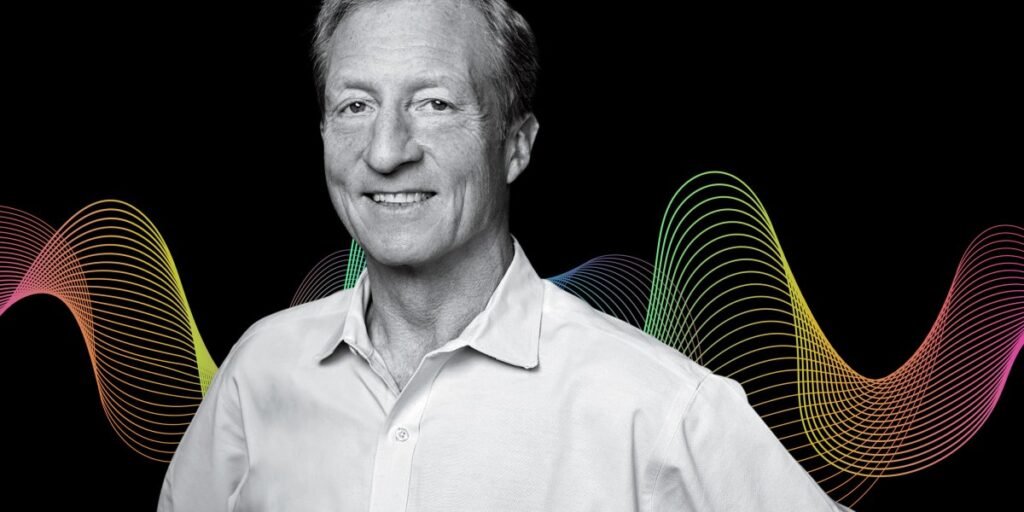
On this episode of Fortune’s Leadership Next podcast, host Diane Brady talks to Tom Steyer, co-executive chair of Galvanize Climate Solutions. A former hedge fund manager and candidate for president in the 2020 race, Steyer is now focused on investments in innovations in the climate space. The conversation ranges over topics from China, electric vehicles, and the political makeup of Silicon Valley, to making sure policy makers have all the facts they need when it comes to topics like energy, climate change, and saving the planet.
Listen to the episode or read the transcript below.
Transcript
Diane Brady: Leadership Next is powered by the folks at Deloitte who, like me, are exploring the changing roles of business leadership and how CEOs are navigating this change.
Welcome to Leadership Next, the podcast about the changing rules of business leadership. I’m Diane Brady. A lot of us know Tom Steyer as a political fundraiser and Democratic presidential candidate back in 2020. But Steyer made his billions as a hedge fund manager and in recent years as a climate investor who believes the next wave of wealth will come from innovations that save the planet. I spoke with Tom about where he’s placing his bets to save the climate and the political climate. Take a listen.
Hi, everyone. Thanks for joining us. I’m here with Tom Steyer. Tom, thank you for being here.
Tom Steyer: Diane, it’s great to be here with you.
Brady: I want to start with, what I still call a tweet, with this post that you had on X recently where you said “2024 is the choice between leading the climate economy or surrendering the economic opportunity of a generation to China.” Tell me more about that. Does it matter if China wins in this scenario since we’re talking about global climate change? I would think we’d want everybody…
Steyer: To do well.
Brady: …you know, all hands on deck.
Steyer: I think that is true. But let’s talk about the role that China is playing, which is kind of an ironic role.
Brady: Yeah.
Steyer: So if you would look at electric vehicles, if you’d look at batteries, if you’d look at wind turbines, if you’d look at solar panels, China is the biggest producer.
Brady: Yup.
Steyer: They are electrifying faster than any other country in the world. They also have no oil and gas, so they have an absolute incentive to do this. Okay, so all of that from what you’re saying, which is true, is that’s good. They are also by far the biggest CO2 emitter in the world. They’re about a third of global CO2 emissions. The United States, by contrast, is somewhere around 11% of global CO2. So they are basically using very dirty energy to try and win economically in the race to get to a clean energy transition. Somewhat ironic. And they see it when you look at China and you study their economy, I think everybody’s noticed that it’s a big slowdown. That they have huge problems in real estate. They have real problems in their state-owned enterprises. That they have gigantic actual issues. And the thing that they are hoping will pull them out of that ditch is exporting clean energy technology and clean energy products. From our standpoint, do we want to give up the car industry? Really? That is a huge global industry. Do we want to give up the energy generation business? I can’t see why. Those are two gi…we have technology to do this. Do we want to focus on it and succeed as a country that has traditionally wanted to lead the world? And in addition, do we want to be the people who are going to lead the coalition to set standards globally, to set enforcement globally, to make sure that as a globe, we move to the new generation, we move to the new technologies, and as a result, we solve a big crisis? Or are we going to trust somebody else to do this who does not have a history of being a great partner?
Brady: It’s interesting because you’re at such an interesting nexus of the role of government and business. Obviously, you built this massive hedge fund. What did it go from $6 million to more than $20 billion, I think, in 25 years? So, kudos to you for that. Talk a little bit about the role of government, because, you know, I know that you ran obviously to be the Democratic candidate in the last election. The Inflation Reduction Act, the CHIPS Act, clearly, those have been factors potentially as catalysts toward the green economy. How important is it that we get a certain regime in because business is moving in this direction anyway?
Steyer: I mean, I wrote a book basically making the point that this is an economic opportunity and the only way it’s going to happen is by winning in the marketplace. So, I’m an absolute believer in business and absolute believer in capitalism. But having said that, this has to be a public-private partnership. So, if we can take a step back and talk about why we’re talking about this at all. Do we need to talk about an energy transition? Why is this not just something that happens in the world of commerce without any conversation or politicization?
Very simply, the world has run on fossil fuels for a long time, and the use of fossil fuels is very highly correlated with an increase in incomes for the people in those countries. So you can go back and see that we’ve gotten a lot richer as a people, not just in the United States, but around the world as we’ve used fossil fuels. There was no intention to emit CO2. There was no intention to create global warming. There was no intention to have vast unintended consequences. But we did. So the real issue here is we have a huge industry polluting in a very destructive way, which they never intended to do, but which they’re not paying for. And they love it. And who wouldn’t? So it’s like, of course they do. But the issue is when we talk about government, okay, what is the IRA? It was basically subsidies for clean industries. So instead of taxing polluters, they’re paying people to produce things that don’t pollute. It’s kind of a tax on its head, a subsidy for non-polluters.
Brady: Because the straight marketplace won’t work. One quote I like from your book that you’re skeptical of any solution that requires humanity’s collective heart to grow three sizes. Nice allusion to the Grinch there. But talk about it’s our instinct to do the right thing, is it just inertia?
Steyer: Well, let me say this and I’ll give you an example, because this actually is happening. The statistic I like to use the most is this one. In the last year, 2023, of new electricity generation globally, 86% of it was renewable, 14% of it was fossil fuels.
Brady: So the business case is compelling.
Steyer: And the reason people did that, no one did that to be nice. There was no person who said, I’m willing to pay higher for clean energy. It turns out that solar and wind are much, much, much cheaper than natural gas. And that is, that is a disparity that is only going to widen if you look at it. As we all know, there is a $14,000 Chinese plug-in hybrid that will go 1200 miles.
Brady: From BYD?
Steyer: From BYD. My point being, look, technology beats dead dinosaurs and that is a spread, batteries got 80% cheaper in the last decade. They’ll get 80% cheaper again this decade. Solar costs are down to a penny per kilowatt hour. Are they going to go lower? Yes.
Brady: So that’s the power of innovation.
Steyer: And that’s the power of business and commerce and intentionality. Yes, but there’s a lot more to it than that. And the question is, how fast do we deploy the existing technologies? How fast do we create and deploy the new technologies and the problems that haven’t been solved?
Brady: Can I go back a second to when you were building your business because you started on Wall Street?
Steyer: I have a totally traditional financial background.
Brady: Well, and it served you well, let’s put it that way. But would you have been able to make money through the nineties, through the early aughts in any kind of climate investment? Or is it really that this moment in time because Galvanize started in 2021?
Steyer: Well, I mean, look, when Jimmy Carter was putting solar panels on the roof of the White House in the 1970s, that energy was far more expensive…
Brady: Sure.
Steyer: …than fossil fuel energy. And he was doing it for different reason. He was doing it because the oil embargo.
Brady: Yeah.
Steyer: Nowadays it’s much cheaper. I mean, what’s happened is the costs have crossed. In new technologies there is a thing called the S-curve. So it’s like you go along trying to get better than the existing technology. And when the cost curves and the efficiency cross and now the new technologies better, it goes up like almost in straight line and it levels out at about 80%. And that’s going back to, you know, replacing whale oil in the 1840s.
Brady: I want to pause because you are in San Francisco, so not necessarily of Silicon Valley, but around there. And Silicon Valley has had been lukewarm at best to the Democrats, not because of the climate issues, but more because of antitrust and other regulatory issues. I know you’re not in the government, so I don’t want to make you a spokesperson for government, but how do you think about the overall business agenda?
Steyer: So let me take one step back and then I’ll address the overall business agenda. But first, let me address Silicon Valley. I mean, I do live in San Francisco and I’ve lived in California for 40 years or more. And people love to write about people in Silicon Valley who are actually Republicans and support Mr. Trump. It’s sort of a man bites dog story.
Brady: And Andreessen Horowitz came out too.
Steyer: Right. And so but to a very large extent, the Valley remains what I would consider moderate Democrat. Very business oriented, very data driven, very liberal socially and overwhelmingly in my mind, still supportive of Kamala Harris for the next president. There are a group of people, many of whom have actually left Silicon Valley and now live in Austin or Miami, who don’t like the way California is run, who don’t like high taxes and who are, as you said, worried about antitrust. Having said that, when I look back at what is, you know, creates business success in my mind, the times when America was growing the fastest, we had very, very high marginal tax rates. Very high. Much higher than today, maybe double today. During Eisenhower, during Kennedy, during LBJ, we had really high marginal tax rates in this country. We didn’t have the disparity in income. If you look at the simple, ‘How much does the CEO of a company make compared to how much does the lowest worker in that company make?’
Brady: It’s like three or four hundred times.
Steyer: It was a fraction of that. It was a much more more equal society in multiple ways. So I’m confident that this idea of low taxes, low government, everybody get out of the way, I mean, it just doesn’t work. That is not the means for a successful society. If you look state by state, how people have done, look, I mean, people are very mad at California who don’t live in California, but California has a really high, we’re the fifth biggest economy in the world. We have incredibly successful businesses. So to me, this whole idea that cut taxes, cut government, cut taxes, cut government, cut support, get rid of education, that can’t help, get rid of, you know, everything, I don’t think that makes any sense. And so it has never worked. That’s not what the data says. But if you have an income stream of X dollars and you can either tax it at 50% or 25%, people are like, I much prefer 25%. That’s much better.
Brady: Exactly. Human nature comes into play.
[Music starts.]
The best business leaders today know the value and importance of empowering those around them personally and professionally. By encouraging and enabling others to grow, take risks, and fuel innovation, business leaders are not only driving greater engagement in performance, but also future proofing their organization for years to come. I’m joined by Jason Girzadas, the CEO of Deloitte US, to talk more about this. Welcome, Jason.
Jason Girzadas: Well, thank you, Diane. Great to be here.
Brady: Innovation is about empowering the people around you, and that’s something that a lot of CEOs struggle with. How do they embed it into their leadership style?
Girzadas: Well, I think there’s all types of CEO leadership styles, clearly, and proving that there’s maybe not one recipe for success. But it does require, I do believe, a commitment to inclusive leadership where all are expected and invited to contribute around innovation. I think there’s also a collaboration and a collaborative culture that’s a requirement. That’s also not something that maybe comes as naturally and has to be cultivated and be intentional about. And then also, I think giving leaders some autonomy to actually look at opportunities for innovation, look at opportunities for creative new ideas to bring forward. That requires a degree of trust and a degree of openness by CEOs in particular to allow for that within an organization.
Brady: So, Jason, I want to, on a personal note, I’m talking to a CEO here. What are some of the most effective strategies you think for fostering open dialogue, collaboration, a lot of what you’re talking about as the ingredients to innovation?
Girzadas: Well, for me, it starts with being genuine and authentic as a leader. Being clear that the single leader doesn’t have all the answers to every question, and certainly in my case, it’s inviting a very broad organization to participate in addressing the issues and challenges that we face. So, I think that genuineness and that transparency and authentic leadership style is the key ingredient from my experience.
Brady: Good advice. Thanks for joining us, Jason.
Girzadas: Thank you, Diane.
[Music ends.]
Brady: One thing that—maybe it’s a symptom of the polarized times we’re in—but business leaders are often remarkably silent on political issues. One, because you get very attacked now, it’s quite transparent. You know, things go viral. I was speaking to Steve Ballmer the other day about his USA Facts that he’s trying to get out there to correct misinformation. I’d love to get your thoughts. Obviously, I know you’ve been in the political arena, but what is the role of business leaders in speaking up about these topics, climate change or otherwise?
Steyer: Well, let me say what I would like my role to be and how I perceive as a professional investor and professional businessperson, how I would like to be. And of course, I have my opinions, just like the other 330 million Americans.
Brady: Yeah.
Steyer: But what I would like to do is have enough granular information that I can share accurately with elected officials and people in government so that they can make better decisions. You know, I’m obviously focused on the energy transition and on climate. I know that people in Washington, D.C. can’t go to venture capital meetings on Sand Hill Road, but I can.
Brady: But are facts what drive decision making in Washington?
Steyer: Not always. I take your point, but I want the people who are making decisions to know the facts. And it’s, they can’t get them on their own, there’s just 24 hours in the day, they have a full-time job, they can’t do it. I view what I would like to do is to be able to say, This is what we’re seeing. These are the actual numbers. You should know this is what solar cost. This is where it’s going. This are where batteries are going. You’re looking at this technology for direct air capture. This is what we see in terms of the cost per ton of sequestration. This is what we see in terms of scalability. You can believe this or not, you can get your own experts. But we’ve looked at this seriously. We’re investing basis on this research. That’s what we see. You should take in.
Brady: You know, it’s interesting. We always talk about what the private sector can bring to the public sector. You know, efficiency facts, getting things done. We rarely talk about what the public sector can bring to the private sector in terms of how you get things done. I’m curious, even your time on the campaign trail. Were there any lessons gleaned from that that you’ve taken into?
Steyer: Well, look, let me say this. And you can see this very granularly this year. The people who are running corporations, particularly public corporations, believe that their career success, their jobs, their pay, and their integrity—very importantly—is based on increasing earnings for their shareholders. And so any time they’re telling you that there’s something more important to them than increasing earnings for their shareholders, I would check my watch to see if they lifted it. They have a job to do with an integrity and responsibility they take seriously. Those are not people who should be setting the agenda for this country. They should be setting the facts. They should be implementing. They should be working within the framework that elected officials, who are the embodiment of the people, set. And so, look, elected officials have a different responsibility. Their job, their integrity, their success, their reputation involves getting re-elected or elected in the first place, which means satisfying people that they’re representing in a significant way. That’s their job. And so, I try not to mix up two different things. And I think that any time you see someone in one of those spheres talking about how they’re really concerned about the other sphere, you have to wonder if it’s true.
Brady: The decision making is different too.
Steyer: Yes. And so I view it as it’s got to be, the way the United States has traditionally worked is, we’re a democratic society, the will of the people rules. They set the rules. They should set the rules. That’s our morality, integrity. And within that box, business people work.
Brady: So you call yourself an optimist. Let’s drill down on that a little bit. Let’s talk about the optimistic investor. Where are your biggest bets right now?
Steyer: My old friend and partner, Katie Hall, and I started a multi-strategy investment firm to invest into the energy transition in multiple strategies. So that includes venture and growth and includes real estate, buying buildings and turning them to net zero, it involves public stocks. But we have plans to do many strategies because we believe this transition, as I said, inevitably has to happen, is happening very fast, that it’s a huge tailwind to investing so that there is a strong commercial argument that this is a place where people, professional investors with great experience, can marry that to domain expertise, specific knowledge of these markets and get very good returns and also have great impact.
Brady: As a citizen, I suppose, are you worried about the state of democracy right now?
Steyer: We obviously, from my standpoint, we have someone who has a real chance to be president who tried to overturn the last election.
Brady: You paid $10 million, I think, to try and win the impeachment battle. I remember that.
Steyer: (laughs) Who I think is, you know, who has been convicted of 34 felonies, who has made multiple statements about what he would do in terms of the law and in terms of future elections if he’s elected. It’s a little hard to read between all the very confusing statements. But clearly, somebody who is not someone who loves elections, not someone who loves democracy, and not someone who respects it. So am I worried about that? I think that that would be a big threat to democracy. Do I believe that the American people will get back their democracy if we ever lose it? Yes, I believe it’s built into us in a very deep way. It is built into me in a very deep way, and I’d be willing to go a very far piece to try and make sure we secure it. But is there someone running for president who has said things that are profoundly undemocratic and has made threats to our democracy repeatedly and said talked about things he was going to do and then has lived up to it in the past. I think we all know that that’s true. So that’s scary.
Brady: Is there anything else on your radar right now you want to put on ours?
Steyer: I would say this: I do think the technology is better than people understand in terms of climate. Our ability to solve these problems is much better than people understand. It’s also true that the news from the natural world, which I follow obsessively, is worse than people understand, and in some cases far worse and far scarier than people understand.
Brady: It’s adaptability as much as fighting climate change.
Steyer: So I know this is a real race between what’s going on, the deterioration of the natural world that we all rely on, and the incredible progress in the technological world. But if we win that race and you step back and think about where we’re going to be as human beings, as Americans, we will be able to create a much better world than we’ve ever imagined. You know, in terms of health, in terms of education, in terms of equality, in terms of all the important parts about life. We’re going to have an ability, given the other advances that we’re making, which are incredible, to really provide a way of living for the people in America and including people all over the world, that is really almost better than we can imagine. And that’s why I’m so focused on trying to make sure that we have a sustainable natural world, because we do depend on it. And if we don’t, then we’re not going to have time to focus on this because we’re going to live in a chaotic, dangerous, unhealthy, and scary world.
Brady: Living to 100 doesn’t make much difference if you can’t go outside.
Steyer: And I’ll give you one small example. I mean, one of the things that the U.N. projects is that on the course we are going, we will have 20 to 25 million climate refugees per year. Syria had 5 million refugees partly related to climate, and that completely roiled Europe as they moved into different countries in Europe. Twenty to 25 million refugees a year, every year. That is something that is a profound threat to the security of our political systems around the world.
Brady: So, let’s drill down a little on the actual technologies that you’re investing in that you think are exciting right now.
Steyer: So, let me say this. We are deploying a lot of existing technologies like wind and solar and EVs and batteries that everybody knows about that are getting much better. But we all know that. What people don’t know is that there are literally hundreds of new technologies being developed, not only to see if they work, but to see if they work at a price that works for customers. And that is a real difference. So, for instance, one of the things that I find fascinating is for a long time we’ve had what’s called geothermal energy. That’s basically hot water under the Earth. So if you think about Old Faithful in Yellowstone, the water comes up, it’s hot, it’s energy, you can use it, just the way you can use natural gas or wind or solar. What’s changed is people are now using basically techniques from oil and gas to go down 5,000 feet, not 500 feet, but 5,000 feet, and they are able to get completely clean baseload energy. So there’s no question about when the wind doesn’t blow or the sun doesn’t shine. It’s always there. Baseload energy that is completely clean emits no CO2 and which is commercial. So it can be done at a price that competes. Now, there’s a real question about how big this can be. But this is one of a hundred technologies where you go like, Oh, God.
Brady: Breaking down plastics. I’ve seen a lot of those as well.
Steyer: There is, I’ve seen techniques on plastics that are amazing. We know there’s plastic pollution. We recycle only 6% of plastics. Only 6%, 94% does not get recycled. So the question is going to be, how are we, first of all, going to pick it out, sort it, and reuse it? There are amazing technologies going on in that involving all kinds of different skills and really incredible new machines. So as we see this, it’s exciting to know that there’s a machine that can look at this and pick out 10,000 different items. Humans can’t do that. That’s incredible.
Brady: So let me clarify, you invest in, so you’re not investing seed capital, first of all. You’re investing in these companies. Are you helping them to replicate at scale? Is that part of what you’re doing?
Steyer: We’re doing multi-strategy. So we do do seed. We do do venture and growth. We do do real estate. I mean, what we’re trying to do is figure out strategies where basically we can be really profitable in decarbonization. We’re not concessionary. We’re not asking people not to get good returns. We’re not at all concessionary. In fact, we believe this transition is a tailwind that has to happen. Doesn’t mean every company will succeed. You still have to be a professional investor. You have to have domain expertise in this area. You have to marry the two and that’s the structure.
Brady: And doing good doesn’t mean you can’t make a good return.
Steyer: If you’re not getting a good return, you’re not going to get a chance to get built.
Brady: All right. Thanks for joining us, Tom.
Steyer: Diane, thank you so much for having me.
Brady: Leadership Next is edited by Nicole Vergalla. Our audio engineer is Natasha Ortiz. Our producer is Mason Cohn and our executive producer is Hallie Steiner. Our theme is by Jason Snell. Leadership Next is a production of Fortune Media
Leadership Next episodes are produced by Fortune‘s editorial team. The views and opinions expressed by podcast speakers and guests are solely their own and do not reflect the opinions of Deloitte or its personnel. Nor does Deloitte advocate or endorse any individuals or entities featured on the episodes.






